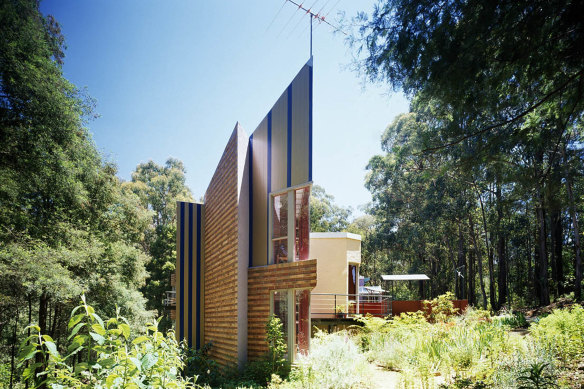- Analysis
- Money
- Saving
- Collectables
Love it or loathe it, 1980s architecture is back in the frame
By Stephen Crafti
Architecture, interior design, furniture and fashion are intrinsically linked – with a movement in one spurring interest in another.
Whether it’s the return of big shoulder pads or the Memphis movement from the early 1980s, sometimes it’s difficult to pinpoint when and where there’s a shift in direction.

Athan House in Monbulk, on the outskirts of Melbourne, circa 1986.
While post-war modernist architecture from the 1950s started to gain traction in the mid-to-late 1990s, with the advent of magazines such as wallpaper*, in the past five years there’s been a greater focus on 1970s design.
And love it or loathe it, architecture from the 1980s is starting to gain traction – think of architects such as Michael Graves, who made his indelible mark on the period with his architecture, furniture and objects.
Architects such as Peter Corrigan and Maggie Edmond created not just a ripple but an avalanche with their buildings from this period, including RMIT University’s Building 8 in Melbourne’s Swanston Street, were completed in the early 1990s.
Recognised for their theatres, churches, galleries, townhouses and detached homes, their designs captured the energy of a city looking for direction; not just in architecture but also in fashion. As with some of Graves’ designs, Edmond’s and Corrigan’s buildings from this period, and well into the present, are graphic and colourful, combined with a sense of wit.
Maggie Edmond, who received the gold medal in 2023 from the Australian Institute of Architects, 20 years after it was received by her late partner, Peter Corrigan, reflects on the 1980s. “Then, it was easier to identify which building was designed by which architect, with many having a clearly defined approach,” she says. Edmond recalls some of the constraints placed on architects even then.
The couple’s Athan House in Monbulk, on the outskirts of Melbourne, circa 1986, was a riot of colour. “We were told by the local council that the exterior colour palette had to be ‘muted’. They certainly wouldn’t entertain our scheme, which included pinks, magentas and turquoise,” says Edmond, who was allowed to proceed after a letter was sent to the council by Patrick McCaughey, who became director of the National Gallery of Victoria in 1981.
“From memory, the letter focused on the word ‘muted’“, says Edmond, who took her colour inspiration from the birdlife in the area. Edmond, like many architects working post-COVID, also sees the escalation of construction costs.

Jeffrey Smart, Portrait of David Malouf, 1980.Credit: Art Gallery of Western Australia
In the 1980s, costs were moderate by today’s standards. Now the cost of a build or renovate makes things more difficult to achieve, she says.
While some enjoy seeing Edmond and Corrigan’s buildings from the window of a passing tram, others, such as Diane and her family, have the pleasure of living in a townhouse in North Carton, designed by Edmond and Corrigan in the late 1980s.
The three-bedroom home, known as “Valmorbida”, is one of three townhouses and has been her home since 1997 after purchasing it from the original owner.
“The townhouses changed hands in 1997 and the three separate families still live here,” says Diane, who loves the way the central passage spans out to the kitchen located at the rear.
“You get a sense of the drama as soon as you enter the front door. And Maggie was always recognised for her great sense of colour,” she adds.
Diane also enjoys the window shapes as well as the careful articulation of skylights, the latter framing majestic gum trees in a neighbouring backyard.
There are other architects who made their mark in the 1980s – including Daryl Jackson and Nic Bochsler in Melbourne and William Zuccon and Allen Jack + Cottier in Sydney. While some, such as Jackson, took a more earthy approach, with exposed or rendered brick walls, others such as Nic Bochsler showed what could be achieved with soaring glass walls, voids and black granite floors.
One of Bochsler’s homes in Toorak from a tad later in the 1990s is presently on the market, with an estimate of $20 million. Framed by a sprawling garden, on a plot of about 1600 square metres, the eye-watering price is still, according to Michael King, prestige sales agent for Abercrombys, good buying.
“If it was a recently completed house you would expect to pay closer to $30 million for a similar property of this size and location,” says King, who sees architect-designed homes from this period as “waiting in the wings”. He also acknowledges that homes from this decade are a little tougher to sell in the present market.
“People generally get more conservative in these times. They don’t often see the upside of buying into a certain period before it becomes more mainstream,” says King, who sees the timing for these homes being “on the money”.
“You’re saving 15 per cent (less than a new home) and, if you’ve noticed, glass bricks are back!”
Stephen Crafti is a specialist in contemporary design, including architecture, furniture, fashion and decorative arts.
For expert tips on how to save, invest and make the most of your money, delivered to your inbox every Sunday, sign up for our Real Money newsletter here.